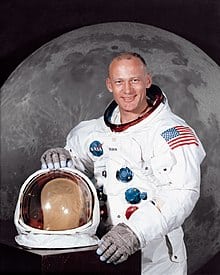Best known as the second person to walk on the moon during the historic Apollo 11 mission, Buzz Aldrin was also a highly decorated Air Force Veteran.
Aldrin was born on January 20, 1930, in Montclair, New Jersey. He was a talented scholar and athlete in high school, but his father wanted him to enroll at the U.S. Naval Academy in Annapolis, Maryland. His desire to fly airplanes led him instead to the U.S. Military Academy at West Point in 1947.
Graduating third in his class, Aldrin had his choice of services to select from. He chose the newly formed Air Force, which did not have its own academy at the time. He was commissioned as a second lieutenant and then assigned to basic flight training at Bartow Air Base in Florida.
Aldrin flew F-86 Sabre jets in 66 combat missions in the Korean War with the 51st Fighter Interceptor Wing based at Suwon Air Base, Republic of Korea. He is widely credited for destroying two enemy MIG-15 fighters. Upon his return to the U.S., he was assigned to Nellis Air Force Base in Nevada, where he served as the Aerial Gunnery Instructor until his reassignment to the Squadron Officers’ School at Air University, Maxwell Air Force Base in Alabama. He logged a total of 3,500 hours of flight time in jets and helicopters during his time with the Air Force.
In 1963, Aldrin completed a Doctorate in Astronautics from the Massachusetts Institute of Technology (MIT). That same year, NASA selected him for their third class of astronauts. In 1966, he broke the record for extra-vehicular activity in space on the Gemini 12 orbital flight mission, spending almost eight hours spacewalking. On July 20, 1969, the world watched as pilot Buzz Aldrin and commander Neil Armstrong made their historic Apollo 11 moon landing, being forever enshrined in history as the first humans to set foot on another celestial body. This seminal event brought the world together in awe for a shining moment in time.
Aldrin and Armstrong spent more than 21 hours on the moon, collecting surface samples. Later that year, President Richard M. Nixon presented Aldrin with the Presidential Medal of Freedom, the highest honor among the 50 medals and distinguished awards he received from the United States and countries around the world.
We honor your service, Col. Buzz Adrin.


















